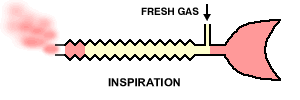 |
|||||||||||||||||||||
|
|
|
Ayre's T-Piece The original Mapleson E system. Construction
A three-way T-tube whose limbs are connected to (F) the fresh gas supply from the anesthesia machine, (R) a length of corrugated reservoir tube and (P) the patient connector. Function
Inspiration
-The patient inspires fresh gas from the reservoir tube. Operational requirements
Modifications
This allows
respiratory movements to be more easily seen and permits intermittent
positive ventilation if necessary. The bag is, however, not essential
to the functioning of the circuit.
Another aid to IPPV is the Kuhn bag, which has the gas outlet on the side of the bag, rather than the tail. This allows the outlet to be occluded with the thumb during IPPV, but leads to difficulties in scavenging the waste gases.
A number of different designs of T-piece are available, which function in essentially the same way.
Modern
T-pieces incorporate 15 mm fittings for the reservoir tube and endotracheal
adapter. The
Normal elbow incorporates a right-angle bend which is convenient
for use in human patients but has little advantage in veterinary
anesthesia. Advantages of T-piece systems
Disadvantages
Uses
|
Comments on this
article should be addressed to Dr Guy
Watney
All pages © Anesthesia Service
and Equipment 1998-2003.







